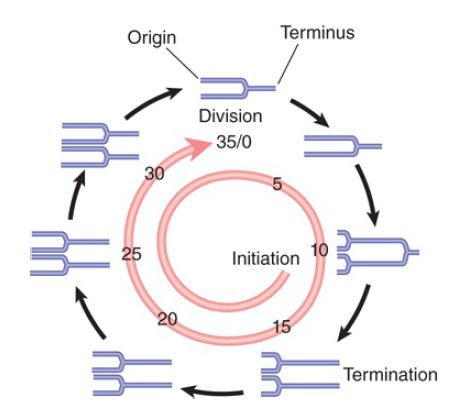


 النبات
النبات
 الحيوان
الحيوان
 الأحياء المجهرية
الأحياء المجهرية
 علم الأمراض
علم الأمراض
 التقانة الإحيائية
التقانة الإحيائية
 التقنية الحيوية المكروبية
التقنية الحيوية المكروبية
 التقنية الحياتية النانوية
التقنية الحياتية النانوية
 علم الأجنة
علم الأجنة
 الأحياء الجزيئي
الأحياء الجزيئي
 علم وظائف الأعضاء
علم وظائف الأعضاء
 الغدد
الغدد
 المضادات الحيوية
المضادات الحيوية|
Read More
Date: 30-10-2020
Date: 15-12-2015
Date: 12-6-2021
|
Bacterial Replication Is Connected to the Cell Cycle
KEY CONCEPTS
-The doubling time of Escherichia coli can vary over a range of up to 10 times, depending on growth conditions.
-It requires 40 minutes to replicate the bacterial chromosome (at normal temperature).
-Completion of a replication cycle triggers a bacterial division 20 minutes later.
-If the doubling time is approximately 60 minutes, a replication cycle is initiated before the division resulting from the previous replication cycle.
-Fast rates of growth therefore produce multiforked chromosomes.
Bacteria have two links between replication and cell growth:
- The frequency of initiation of cycles of replication is adjusted to fit the rate at which the cell is growing.
- The completion of a replication cycle is connected with division of the cell.
The rate of bacterial growth is assessed by the doubling time, the period required for the number of cells to double. The shorter the doubling time, the faster the bacteria are growing. E. coli growth rates can range from doubling times as fast as 18 minutes to slower than 180 minutes. The bacterial chromosome is a single replicon; thus, the frequency of replication cycles is controlled by the number of initiation events at the single origin. Researchers can define the replication cycle in terms of two constants:
- C is the fixed time of approximately 40 minutes required to replicate the entire E. coli chromosome. Its duration corresponds to a rate of replication fork movement of approximately 50,000 bp/minute. (The rate of DNA synthesis is more or less invariant at a constant temperature; it proceeds at the same speed unless and until the supply of precursors becomes limiting.)
- D is the fixed time of approximately 20 minutes that elapses between the completion of a round of replication and the cell division with which it is connected. This period might represent the time required to assemble the components needed for division.
The constants C and D can be viewed as representing the maximum speed with which the bacterium is capable of completing these processes. They apply for all growth rates between doubling times of 18 and 60 minutes, but both constant phases become longer when the cell cycle occupies more than 60 minutes.
A cycle of chromosome replication must be initiated at a fixed time of C + D = 60 minutes before cell division. For bacteria dividing more frequently than every 60 minutes, a cycle of replication must be initiated before the end of the preceding division cycle. You might say that a cell is born “already pregnant” with the next generation.
Consider the example of cells dividing every 35 minutes. The cycle of replication connected with a division must have been initiated 25 minutes before the preceding division. This situation is illustrated in FIGURE 1, which shows the chromosomal complement of a bacterial cell at 5-minute intervals throughout the cycle.

FIGURE 1. The fixed interval of 60 minutes between initiation of replication and cell division produces multiforked chromosomes in rapidly growing cells. Note that only the replication forks moving in one direction are shown; the chromosome actually is replicated symmetrically by two sets of forks moving in opposite directions on circular chromosomes.
At division (35/0 minutes), the cell receives a partially replicated chromosome. The replication fork continues to advance. At 10 minutes, when this “old” replication fork has not yet reached the terminus, initiation occurs at both origins on the partially replicated chromosome. The start of these “new” replication forks creates a multiforked chromosome.
At 15 minutes—that is, at 20 minutes before the next division—the old replication fork reaches the terminus. Its arrival allows the two daughter chromosomes to separate; each of them has already been partially replicated by the new replication forks (which now are the only replication forks). These forks continue to advance.
At the point of division, the two partially replicated chromosomes segregate. This recreates the point at which we started. The single replication fork becomes “old,” it terminates at 15 minutes, and 20 minutes later, there is a division. We see that the initiation event occurs 1 / cell cycles before the division event with which it is associated.
The general principle of the link between initiation and the cell cycle is that as cells grow more rapidly (the cycle is shorter), the initiation event occurs at an increasing number of cycles before the related division. There are correspondingly more chromosomes in the individual bacterium. This relationship can be viewed as the cell’s response to its inability to reduce the periods of C and D to keep pace with the shorter cycle.



|
|
|
|
كيف تعزز نمو الشعر الصحي؟
|
|
|
|
|
|
|
10 فحوصات مهمة يجب القيام بها لسيارتك قبل الصيف
|
|
|
|
|
|
جامعة الزهراء (عليها السلام) تكرم قسم الشؤون الفكرية بمناسبة اليوم العالمي للكتاب
|
|
|
|
قسم شؤون المعارف يقيم ندوة علمية حول جهود علماء البصرة في نشر الحديث
|
|
|
|
قسم الشؤون الفكرية يختتم برنامجاً ثقافياً لوفدٍ من جامعة البصرة
|
|
|
|
جامعة الكفيل تعقد ورشة عمل عن إجراءات عمل اللجان الامتحانيّة
|